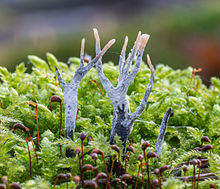Xylaria hypoxylon is a species of bioluminescent fungus in the family Xylariaceae. It is known by a variety of common names, such as the candlestick fungus, the candlesnuff fungus, carbon antlers,[1] or the stag's horn fungus.[2] The fruit bodies, characterized by erect, elongated black branches with whitened tips, typically grow in clusters on decaying hardwood. The fungus can cause a root rot in hawthorn and gooseberry plants.[3]
| Xylaria hypoxylon | |
|---|---|

| |
| Scientific classification | |
| Domain: | Eukaryota |
| Kingdom: | Fungi |
| Division: | Ascomycota |
| Class: | Sordariomycetes |
| Order: | Xylariales |
| Family: | Xylariaceae |
| Genus: | Xylaria |
| Species: | X. hypoxylon
|
| Binomial name | |
| Xylaria hypoxylon | |
| Synonyms | |
| No distinct cap | |
| Hymenium attachment is not applicable | |
| Lacks a stipe | |
| Spore print is black to white | |
| Edibility is inedible | |
Taxonomy edit
Xylaria hypoxylon was first described by Carl Linnaeus in 1745,[4] and then later mentioned by him in his Species Plantarum II.[5]
The specific epithet is derived from the Greek words hypo meaning "below", and xylon, meaning "wood".
Description edit
Fruit bodies (ascocarps) are cylindrical or flattened with dimensions of 3–8 centimetres (1+1⁄8–3+1⁄8 in) tall × 2–8 mm thick.[1] The erect ascocarps are often twisted or bent, and typically sparsely branched, often in a shape resembling a stag's antlers. Specimens found earlier in the season, in spring, may be covered completely in asexual spores (conidia), which manifests itself as a white to grayish powdery deposit. Later in the season, mature ascocarps are charcoal-black, and have minute pimple-like bumps called perithecia on the surface. These are minute rounded spore bearing structures with tiny holes, or ostioles, for the release of sexual spores (ascospores). The perithecia are embedded in the flesh of the ascocarp, the stroma, which is tough, elastic, and white. Within the perithecia, the asci are 100 × 8 μm.[6]
Ascospores are kidney-shaped, black, and smooth, with dimensions of 10–14 × 4–6 μm.[7] The asexual spores (mitospores) are ellipsoid in shape, smooth, and hyaline.[8]
Edibility edit
Although not poisonous, the small size and tough texture of this fungus deter consumption. It is considered inedible by some guides.[9]
Similar species edit
Many species of the genus resemble X. hypoxylon,[10] including Xylaria polymorpha, which is thicker and not as branched.
Chemical compounds edit
A variety of chemical compounds with in vitro properties have been identified in this fungus. The compounds xylarial A and B both have moderate cytotoxic activity against the human hepatocellular carcinoma cell line Hep G2.[11] The pyrone derivative compounds named xylarone and 8,9-dehydroxylarone also have cytotoxic activity.[12] Several cytochalasins, compounds that bind to actin in muscle tissue, have been found in the fungus.[13] X. hypoxylon also contains a carbohydrate-binding protein, a lectin, with a unique sugar specificity, and which has potent anti-tumor effects in various tumor cell lines.[14]
See also edit
References edit
- ^ a b Sundberg W, Bessette A (1987). Mushrooms: A Quick Reference Guide to Mushrooms of North America (Macmillan Field Guides). New York: Collier Books. p. 10. ISBN 0-02-063690-3.
- ^ "Xylaria hypoxylon". Archived from the original on May 13, 2008. Retrieved 2009-01-26.
- ^ Horst RK, Westcott C (2001). Westcott's plant disease handbook. Boston: Kluwer Academic Publishers. p. 533. ISBN 0-7923-8663-9.
- ^ Linnaeus C. (1745). Flora svecica [suecica] exhibens plantas per regnum Sueciae crescentes. Vol. 2. Stockholm: Salvii.
- ^ Linnaeus C. (1753). Species Plantarum, exhibentes plantas rites cognitus ad genera relatas cum differentiis specificis, nominibus trivialibus, synonymis selectis, locis natalibus, secundum systema sexuale digestas. Vol. II. Stockholm: Salvii.
- ^ "Rogers Mushrooms | Mushroom Pictures & Mushroom Reference". Retrieved 2009-01-27.
- ^ "Xylaria hypoxylon". California Fungi. Retrieved 2009-01-26.
- ^ "Xylaria hypoxylon (próchnilec ga3êzisty) (Candlesnuff Fungus)". Retrieved 2009-01-26.
- ^ Davis, R. Michael; Sommer, Robert; Menge, John A. (2012). Field Guide to Mushrooms of Western North America. Berkeley: University of California Press. pp. 380–381. ISBN 978-0-520-95360-4. OCLC 797915861.
- ^ Audubon (2023). Mushrooms of North America. Knopf. p. 80. ISBN 978-0-593-31998-7.
- ^ Gu W, Ding H. (2008). "Two new tetralone derivatives from the culture of Xylaria hypoxylon AT-028." Chinese Chemical Letters 19(11): 1323–26.
- ^ Schüffler A, Sterner O, Anke H (2007). "Cytotoxic alpha-pyrones from Xylaria hypoxylon". Z. Naturforsch. C. 62 (3–4): 169–72. doi:10.1515/znc-2007-3-403. PMID 17542480. S2CID 34792432.
- ^ Espada A, Rivera Sagredo A, de la Fuente JM, Hueso Rodriguez JA, Elson SW. (1997). "New cytochalasins from the fungus Xylaria hypoxylon." Tetrahedron 53(18): 6485–92.
- ^ Liu Q, Wang H, Ng TB (2006). "First report of a xylose-specific lectin with potent hemagglutinating, antiproliferative and anti-mitogenic activities from a wild ascomycete mushroom". Biochim. Biophys. Acta. 1760 (12): 1914–9. doi:10.1016/j.bbagen.2006.07.010. PMID 16952421.
External links edit
- Fungi on Wood Description and photos